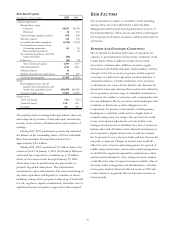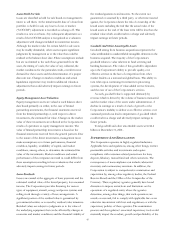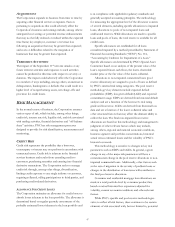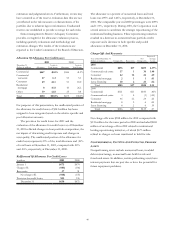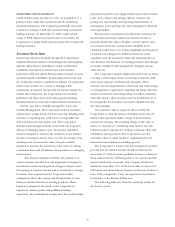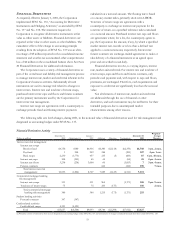PNC Bank 2001 Annual Report Download - page 46
Download and view the complete annual report
Please find page 46 of the 2001 PNC Bank annual report below. You can navigate through the pages in the report by either clicking on the pages listed below, or by using the keyword search tool below to find specific information within the annual report.44
STRATEGIC REPOSITIONING
The Corporation took several actions in 2001 to accelerate
the strategic repositioning of its lending business that began
in 1998. These actions entail a degree of risk pending
completion.
At December 31, 2001, $5.0 billion of institutional
lending credit exposure including $2.6 billion of outstandings
were classified as held for sale. A total of $169 million of
these loans was included in nonperforming assets at that
date. The loans are carried at the lower of cost or estimated
fair market value. The estimation of fair market values
involves a number of judgments, and is inherently uncertain.
In addition, the value of loan assets is affected by a variety of
company, industry, economic and other factors, and can be
volatile. If the value of loans held for sale deteriorates prior
to disposition, valuation adjustments will be made through
charges to earnings. Moreover, deterioration in the condition
of the borrowers could lead to additional loans being placed
on nonperforming status. See Critical Accounting Policies
and Judgments for additional information.
During the fourth quarter of 2001, the Corporation
decided to discontinue its vehicle leasing business and
recorded charges of $135 million related to exit costs and
additions to reserves related to insured residual value
exposures. At December 31, 2001, approximately $1.9 billion
of vehicle leases remained on the Corporation’s books.
These leases are expected to mature over a period of
approximately five years. During this period, the Corporation
will continue to be subject to risks inherent in the vehicle
leasing business, including credit risk and the risk that
vehicles returned during or at the conclusion of the lease
term cannot be disposed of at a price at least as great as the
Corporation’s remaining investment in the vehicles after
application of any available residual value insurance or
related reserves.
In January 2001, PNC sold its residential mortgage
banking business. Certain closing date purchase price
adjustments aggregating approximately $300 million pretax
are currently in dispute between the parties. The Corporation
has established a receivable of approximately $140 million to
reflect additional purchase price it believes is due from the
buyer. The buyer has taken the position that the purchase
price it has already paid should be reduced by approximately
$160 million. The Corporation has established specific
reserves related to a portion of its recorded receivable. The
purchase agreement requires that an independent public
accounting firm determine the final adjustments. The buyer
also has filed a lawsuit against the Corporation seeking
compensatory damages with respect to certain of the
disputed matters that the Corporation believes are covered
by the process provided in the purchase agreement,
unquantified punitive damages and declaratory and other
relief. Management intends to assert the Corporation’s
positions vigorously. Management believes that, net of
available reserves, an adverse outcome, expected to be
recorded in discontinued operations, could be material to net
income in the period in which recorded, but that the final
disposition of this matter will not be material to the
Corporation’s financial position.
CRITICAL ACCOUNTING POLICIES AND
JUDGMENTS
The Corporation’s consolidated financial statements are
prepared based on the application of certain accounting
policies, the most significant of which are described in
Note 1 Accounting Policies. Certain of these policies require
numerous estimates and strategic or economic assumptions
that may prove inaccurate or subject to variations and may
significantly affect PNC’s reported results and financial
position for the period or in future periods. Changes in
underlying factors, assumptions, or estimates in any of these
areas could have a material impact on PNC’s future financial
condition and results of operations.
Allowance For Credit Losses
The allowance for credit losses is calculated with the
objective of maintaining a reserve level believed by
management to be sufficient to absorb estimated probable
credit losses. Management’s determination of the adequacy
of the allowance is based on periodic evaluations of the
credit portfolio and other relevant factors. However, this
evaluation is inherently subjective as it requires material
estimates, including, among others, expected default
probabilities, loss given default, expected commitment usage,
the amounts and timing of expected future cash flows on
impaired loans, value of collateral, estimated losses on
consumer loans and residential mortgages, and general
amounts for historical loss experience. The process also
considers economic conditions, uncertainties in estimating
losses and inherent risks in the various credit portfolios. All
of these factors may be susceptible to significant change.
Also, the allocation of the allowance to specific loan pools is
based on historical loss trends and management’s judgment
concerning those trends. Commercial loans are the largest
category of credits and are the most sensitive to changes in
assumptions and judgments underlying the determination of
the allowance. As such, approximately $467 million or 74%
of the total allowance at December 31, 2001 has been
allocated to the commercial loan category. This allocation
also considers other relevant factors such as actual versus
estimated losses, regional and national economic conditions,
business segment and portfolio concentrations, industry
competition and consolidation, the impact of government
regulations, and risk of potential estimation or judgmental
errors. To the extent actual outcomes differ from
management estimates, additional provision for credit losses
may be required that would adversely impact earnings in
future periods.











